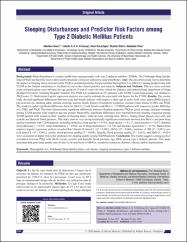| dc.contributor.author | Bener, Abdulbari | |
| dc.contributor.author | A. Al-Hamaq, Abdulla O. A. | |
| dc.contributor.author | Ağan, Ahmet Faruk | |
| dc.contributor.author | Öztürk, Mustafa | |
| dc.contributor.author | Ömer, Abdulkadir | |
| dc.date.accessioned | 2020-12-25T08:30:18Z | |
| dc.date.available | 2020-12-25T08:30:18Z | |
| dc.date.issued | 2020 | en_US |
| dc.identifier.citation | Bener, A., A. Al-Hamaq, A. O. A., Ağan, A. F., Öztürk, M. ve Ömer, A. (2020). Sleeping disturbances and predictor risk factors among type 2 diabetic mellitus patients. Annals of African Medicine, 19(4), 230-236. https://dx.doi.org/10.4103/aam.aam_51_19 | en_US |
| dc.identifier.issn | 1596-3519 | |
| dc.identifier.issn | 0975-5764 | |
| dc.identifier.uri | https://dx.doi.org/10.4103/aam.aam_51_19 | |
| dc.identifier.uri | https://hdl.handle.net/20.500.12511/6144 | |
| dc.description.abstract | Background: Sleep disturbance is a major health issue among people with type 2 diabetes mellitus (T2DM). The Pittsburgh Sleep Quality Index (PSQI) has been the most widely used instrument to measure subjective sleep disturbance. Aim: The aim of this study was to determine the impact of sleeping factor structure of the PSQI as potential predictor for glycosylated hemoglobin A1c (HbA1C) among people living with T2DM in the Turkish community to facilitate its use in the clinical practice and research. Subjects and Methods: This is a cross-sectional study and participants were between the age group of 25 and 65 years old who visited the diabetes and endocrinology department of Mega Medipol University Teaching Hospital, Istanbul. The PSQI was conducted on 871 patients with T2DM. Good sleep quality was defined as PSQI score <5. Multivariate logistic regression analysis was used to estimate the associated risk factors for the T2DM. Results: The current study showed significant differences between male and female patients with respect to their age in years, body mass index (BMI) (kg/m2), physical activity, smoking habit, sheesha smoking, income, family history of metabolic syndrome, coronary heart disease (CHD), and PSQI. The results revealed significant differences between HbA1c <= 7 and females and HbA1c >7 T2DM patients with respect to gender, BMI (kg/m2), CHD, and PSQI. The study demonstrated significant differences between sleeping categories PSQI as good, average, and poor sleeping among T2DM patients with respect to age and gender. Meanwhile, significant differences were reported between sleeping categories among T2DM patients with respect to their: number of sleeping hours, wake-up time, sleeping time, HbA1c, fasting blood glucose, uric acid, and systolic and diastolic blood pressure. This study showed very strong statistically significant correlations between low HbA1c and poor sleep quality in patients with T2DM patients, including subjective sleep quality r = 0.763, sleep latency r = 0.327, sleep duration r = 0.472, habitual sleep efficiency r = 0.575, sleep disturbances r = 0.564, use of sleep medication r = 0.728, and daytime dysfunction r = 0.734. Multivariate stepwise logistic regression analysis revealed that Vitamin D (mmol/L) (P < 0.001), HbA1c (P < 0.001), duration of DM (P < 0.001), uric acid (mmol/L) (P < 0.001), systolic blood pressure mmHg (P = 0.006), diastolic blood pressure mmHg (P = 0.015), and BMI (P = 0.024) were considered at higher risk as the predictors for sleeping quality among T2DM patients. Conclusion: The results suggest a strong positive correlation between PSQI with HbA1c levels, systolic and diastolic blood pressure, age, BMI, among type 2 diabetic patients. This study ascertains that poor sleep quality may be due to elevated level of HbA1c, metabolic syndrome, diabetes, obesity, and/or hypertension. | en_US |
| dc.description.sponsorship | Qatar Diabetes Association, Qatar Foundation;
Istanbul Medipol University | en_US |
| dc.language.iso | eng | en_US |
| dc.publisher | Wolters Kluwer Medknow Publications | en_US |
| dc.rights | info:eu-repo/semantics/embargoedAccess | en_US |
| dc.subject | Hemoglobin A1c | en_US |
| dc.subject | Pittsburgh Sleep Quality Index | en_US |
| dc.subject | Risk Factors | en_US |
| dc.subject | Sleeping Disturbances | en_US |
| dc.subject | Type 2 Diabetes Mellitus | en_US |
| dc.title | Sleeping disturbances and predictor risk factors among type 2 diabetic mellitus patients | en_US |
| dc.type | article | en_US |
| dc.relation.ispartof | Annals of African Medicine | en_US |
| dc.department | İstanbul Medipol Üniversitesi, Uluslararası Tıp Fakültesi, Dahili Tıp Bilimleri Bölümü, İç Hastalıkları Ana Bilim Dalı | en_US |
| dc.authorid | 0000-0002-7902-5803 | en_US |
| dc.authorid | 0000-0003-2209-7694 | en_US |
| dc.identifier.volume | 19 | en_US |
| dc.identifier.issue | 4 | en_US |
| dc.identifier.startpage | 230 | en_US |
| dc.identifier.endpage | 236 | en_US |
| dc.relation.publicationcategory | Makale - Uluslararası Hakemli Dergi - Kurum Öğretim Elemanı | en_US |
| dc.identifier.doi | 10.4103/aam.aam_51_19 | en_US |
| dc.identifier.scopusquality | Q3 | en_US |


















